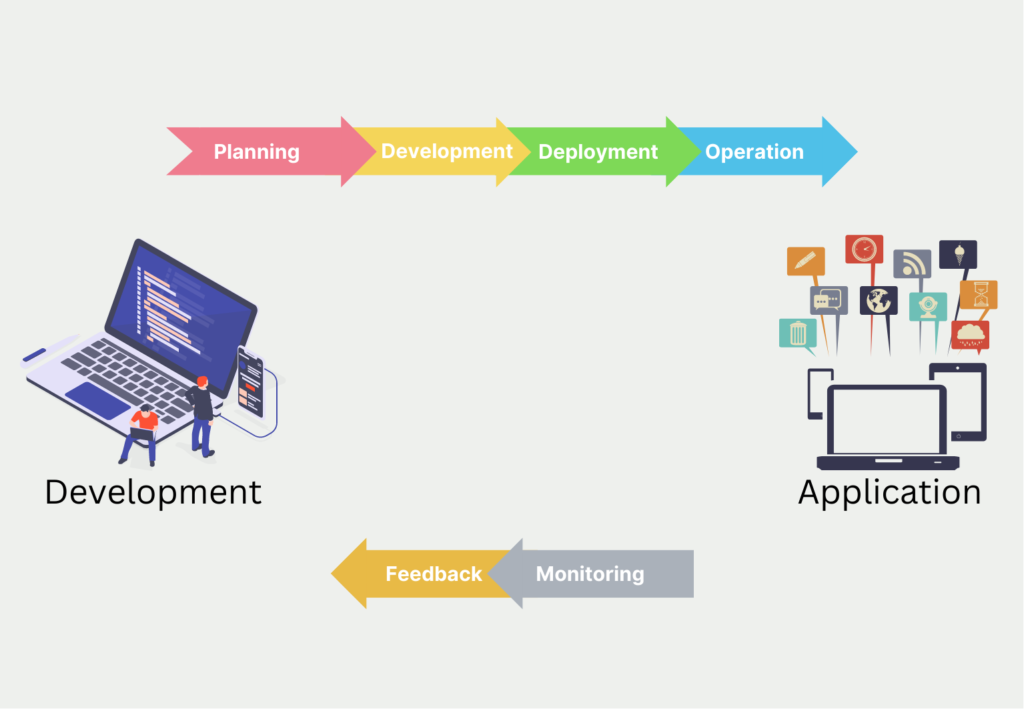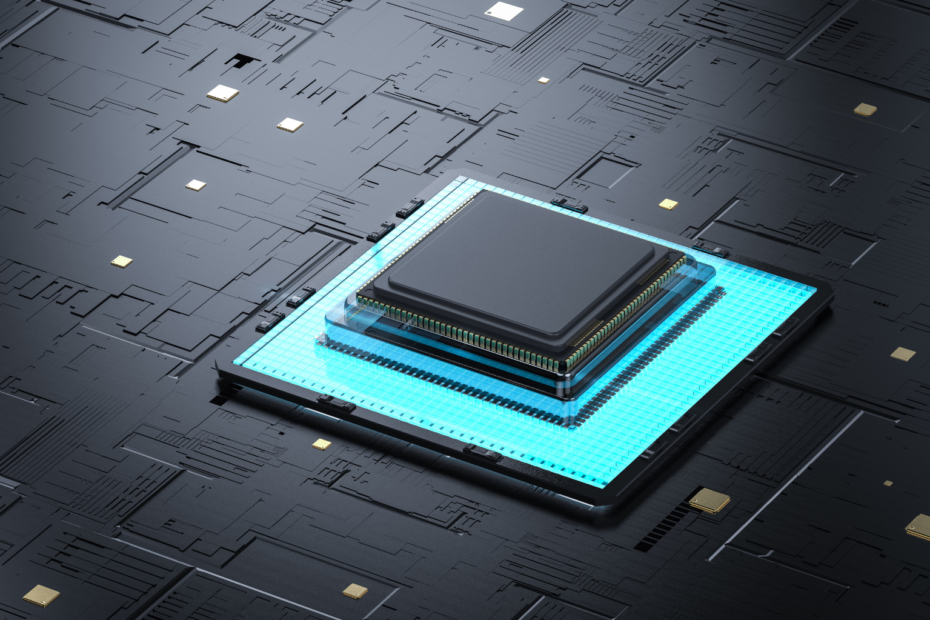Continuous Integration (CI) is a method of agile software development and simplifies the integration of new code into an existing project so that no problems occur. For this purpose, code developments are stored in a common repository, in which they can also be tested directly together and the functionality can be ensured.
How does Continuous Integration work?
In many software projects, it is not sufficient for just a single software developer to program due to the complexity or time component. Thus, a team of developers is faced with the problem that they work simultaneously at different points in the code and must merge their respective work into a common, functioning code.
This can cause additional problems as different versions of modules, such as Pandas or TensorFlow, may be used and differ from the version in the final project. All these issues require a high level of communication from the development team to coordinate and spread the code changes. This is not only very time-consuming but also disrupts the productive work of the developers.
Continuous Integration, therefore, focuses on a central repository in which all code changes made by team members are recorded. This can then be used to centrally test whether the individual components work together without problems. Continuous Integration also includes the idea of uploading the code in many small steps, instead of several thousand lines once at the end of the project. This allows errors to be discovered and corrected earlier, instead of having to search for them at the end of the programming process.
Continuous Integration is mostly used together with DevOps, especially in the development phase of the DevOps lifecycle.
What is the DevOps lifecycle?
The DevOps lifecycle describes the central process within software development. The individual stages are run through once in a project and can continue to be used after completion to improve the application throughout.
Depending on the source, the naming of the stages may differ, but the same process is always described:
- Planning: Before software development can begin, the new application must be planned. This includes tasks such as defining requirements, the composition of the project team, or the schedule up to going live. In this phase, concepts of agile software development are primarily used, such as Kanban boards or Scrum.
- Development: In this phase, the individual parts of the application are programmed, tested, and checked. Functionality testing takes place in various stages that increasingly approach the productive environment. In these, new functionalities can be tested intensively without affecting the production environment.
- Deployment: During deployment, the finished application is made available to end users in a productive environment. This includes the integration of a powerful infrastructure that can handle the expected loads.
- Operation: Shortly after the application has been transferred to a productive system, the operation phase begins, in which the flawless functionality of the program is ensured on a sustained basis. This includes, for example, checking logs during troubleshooting or, if necessary, adapting the infrastructure if the system’s performance needs to be increased.
- Monitoring: In this phase, it is observed how the end users interact with the software and whether it fulfills the requirements from the planning phase or not.
- Feedback: The results of the monitoring phase are now evaluated and it is decided whether an improvement of the application is necessary. Then the lifecycle starts again with the planning phase.

What is the process of Continuous Integration?
As soon as a programmer has to incorporate new functionality into the program, he or she accesses the central repository, which contains the current status of the working code. To ensure that this status is centrally accessible to all, it is usually stored in the cloud.
The developer pulls this state onto his local computer and uses it as a starting point for new code. The new functionality is now developed and tested in this environment. Although Continuous Integration involves very small-step programming, there can be several days between the status from the repository and completion by the developer, during which changes have been made to the repository.

Thus, the developer must ensure that the new code components also match the new repository and work. To do this, he pulls the new status from the repository back into his local environment and merges it with the new code from the last few days. It is now up to the programmer to ensure that the new functionalities work locally with the new additions from the repository. To do this, he fixes all errors that arose during the merge from the current repository and his new code.
Finally, he uploads the working state back to the central repository and tests it there one last time. Only when it has been ensured that the changes now also work properly in the repository is the task complete and the programmer can turn to a new problem.
What are the benefits of using Continuous Integration?
Continuous Integration is now used in most programming projects, as the approach has become established. The following benefits have made a considerable contribution to this:
- Increased Productivity: Programmers can work significantly faster and more focused with the help of Continuous Integration. Time-consuming tasks, such as code tuning or functionality testing, are eliminated or accelerated considerably.
- Error Prevention or fast Bug Fixing: Due to the very small-scale work and the many test cycles, errors in the code occur much less frequently or can be found very quickly, since only small functionalities have been added. As a result, no time is lost due to long error searches.
- Fast Updates: Continuous Integration can also be used for software projects that are already in a productive system. This means that small changes and adjustments can be taken live much more quickly, thus increasing customer satisfaction.
What are the disadvantages of implementing Continuous Integration?
The introduction of Continuous Integration can also lead to some, albeit very few, disadvantages. In most project teams, there has to be a change in the processes to which they are accustomed. In some cases, these have been established for a long time and the employees are used to them. As in other projects, problems can arise with such changes if the employees are not picked up and convinced of the change.
Furthermore, there may need to be architectural changes to build the various environments in which the code can be tested. Depending on the initial architecture, this can be a very complex and also expensive process.
How are Continuous Deployment and Continuous Integration related to CI?
Continuous delivery, continuous deployment, and continuous integration are related practices that are used in modern software development to automate the process of building, testing, and deploying software. Although they are often used together, these practices have distinct purposes and characteristics.
Continuous Integration (CI) is the practice of frequently and automatically merging code changes into a central repository and building and testing the changes. The goal is to detect and fix issues early in the development process before they become more expensive to fix later on. By ensuring that code changes are integrated and tested quickly, teams can maintain a high level of code quality and speed up the development process.
Continuous Delivery (CD) is the practice of automating the entire software release process, from building and testing to deployment. With continuous delivery, software can be released to production at any time, with the push of a button. The goal is to ensure that the software is always ready for release, reducing the risk of human error and speeding up the time to market.
Continuous Deployment (CDep) is the practice of automatically deploying code changes to production as soon as they pass testing. This requires a high degree of confidence in the automated testing process and the code quality. Continuous deployment can help teams reduce the time between developing new features and getting them in front of users, and reduce the time and costs associated with manual deployments.
In practice, these three practices work together to create a continuous feedback loop, where code changes are frequently and automatically integrated, tested, and deployed. This can help teams achieve faster and more reliable software delivery, with fewer errors and more frequent releases.
To implement continuous integration, delivery, and deployment, teams need to use a range of tools and technologies, including version control systems, automated testing frameworks, build servers, and deployment tools. They also need to follow best practices for code management, testing, and deployment, such as maintaining a clean code repository, writing automated tests, and using deployment pipelines to automate the deployment process.
Overall, continuous integration, delivery, and deployment are essential practices for modern software development. By automating the process of building, testing, and deploying software, teams can achieve faster, more reliable releases, with fewer errors and lower costs.
This is what you should take with you
- Continuous Integration (CI) is a method of agile software development that simplifies the integration of new code into an existing project so that no problems occur in the process.
- It is also part of the so-called DevOps lifecycle.
- Continuous Integration can significantly increase the productivity of developers.
What is Collaborative Filtering?
Unlock personalized recommendations with collaborative filtering. Discover how this powerful technique enhances user experiences. Learn more!
What is Quantum Computing?
Dive into the quantum revolution with our article of quantum computing. Uncover the future of computation and its transformative potential.
What is Anomaly Detection?
Discover effective anomaly detection techniques in data analysis. Detect outliers and unusual patterns for improved insights. Learn more now!
What is the T5-Model?
Unlocking Text Generation: Discover the Power of T5 Model for Advanced NLP Tasks - Learn Implementation and Benefits.
What is MLOps?
Discover the world of MLOps and learn how it revolutionizes machine learning deployments. Explore key concepts and best practices.
Other Articles on the Topic of Continuous Integration
The following articles were used as sources for the preparation of this paper:

Niklas Lang
I have been working as a machine learning engineer and software developer since 2020 and am passionate about the world of data, algorithms and software development. In addition to my work in the field, I teach at several German universities, including the IU International University of Applied Sciences and the Baden-Württemberg Cooperative State University, in the fields of data science, mathematics and business analytics.
My goal is to present complex topics such as statistics and machine learning in a way that makes them not only understandable, but also exciting and tangible. I combine practical experience from industry with sound theoretical foundations to prepare my students in the best possible way for the challenges of the data world.





